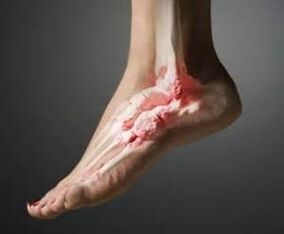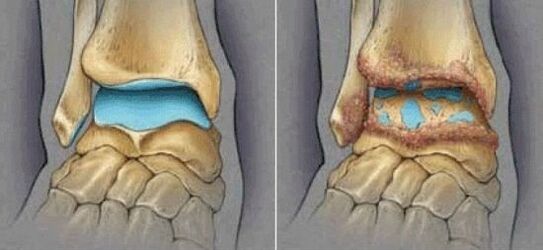
Ankle arthrosis is a dystrophic degenerative pathological disease that is characterized by the gradual destruction of cartilage, joints, and adjacent bone structures, as well as ligaments and even muscles, resulting in reduced mobility and even disability for the patient. The reason for the development of such a pathology can be traumatic injuries, in which post-traumatic arthritis of the ankle develops, metabolic disorders in the body or some inflammatory diseases.
No self-medication. See your doctor at the first sign of illness.
The diagnosis of pathology is made taking into account the patient's complaints, as well as on the basis of the results of the X-ray examination and ultrasound. The disease must mainly be treated conservatively and surgery is only indicated in severe (neglected) cases.
The disease has a chronic undulating course, in which phases of exacerbation alternate with phases of rest, but the progression of the pathology continues even without symptoms, therefore, over time, if the treatment is not carried out, the ankle will be completely destroyed. Most often, the elderly suffer from osteoarthritis due to the natural metabolic processes in the body, but there are also other reasons for osteoarthritis to develop.
causes
There are two types of osteoarthritis in medical practice: primary and secondary. Primarily develops as an independent pathology for no apparent reason. Secondary is the result of side effects, for example traumatic injuries.
The main causes of the onset of the disease can be as follows:
- Diabetes mellitus;
- Thyroid disease;
- Obesity;
- persistent microtrauma that can occur in people who play sports or wear high heels regularly;
- rheumatic diseases;
- traumatic injuries in this area (fracture, dislocation);
- inflammatory processes that develop as a result of diseases such as gout, arthritis;
- hereditary metabolic disorders that lead to tissue thinning.

Sometimes the disease occurs in children, and its causes can be:
- Tissue dysplasia;
- congenital abnormalities;
- Thyrotoxicosis;
- Trauma;
- inflammatory joint disease.
Degrees and symptoms
Ankle osteoarthritis of course has three grades that determine the symptoms of the condition. It is important to remember that the disease develops gradually, so joint discomfort is insignificant at first, and then becomes more and more pronounced. At the same time, the changes that have occurred are already incorrigible, and the treatment of the pathology at one stage or another consists only in preventing the progression of the disease.
At the first degree of the disease, the tissue becomes thinner, and this happens not on the entire surface, but in individual parts - specific islands are formed.
The first-degree disease is characterized by the following symptoms:
- excessive fatigue with prolonged load on the legs;
- Discomfort in the joint area after walking in the heels;
- slight pain that disappears with rest.
X-rays or ultrasound exams do not reveal any pathological changes in the joint, so doctors cannot make a diagnosis at this time.
In the first stage of the disease, it can be treated at home with folk remedies, discussed below.
At the second degree of the pathological process in the areas where the tissue is thinned, the load falls on the underlying bone. Because of this, it grows and forms osteophytes, which injure healthy areas of cartilage tissue that are opposite or nearby. The symptoms of second degree osteoarthritis are already more obvious, these are:
- Less stressful pain that doesn't go away immediately after it's stopped;
- the appearance of night pains that affect the quality of sleep;
- Restricting joint mobility in the morning (it takes time for it to work);
- common reaction to the weather.
In the third degree, deforming osteoarthritis of the ankle develops. During this time, the tissue of the entire joint becomes thinner, as does the bone structures, the muscles on the one hand being overstretched and on the other hand cramping in order to keep the joint in the correct position. Symptoms of the third degree of such a pathology as deforming osteoarthritis of the ankle are associated with a complete violation of its mobility and severe pain:
- severe pain that does not stop even at rest;
- in the morning hours the joint requires long-term development, even to perform minimal movements;
- crunching feeling;
- the need to take pain medication to relieve pain;
- Limitation or even complete impairment of mobility in the affected area.
Pathologies such as traumatic osteoarthritis of the ankle are characterized by some other symptoms:
- Swelling and redness in the affected area;
- local temperature rise;
- Crunch or crepitus.

Diagnosis and treatment
X-rays play a crucial role in diagnosing the disease. However, it is important that the doctor listen to the patient's complaints in order to make an early diagnosis if radiographic changes are not visible. In severe cases, the patient is referred for an ankle CT or MRI.
Treatment for ankle osteoarthritis depends on the stage of the disease. At the initial stage, it is enough to change the way of life and the correct motor regime. Massage and exercise therapy are helpful during this phase to improve blood circulation. If we talk about treatment with folk remedies that can be used at home, it can relieve pain and reduce the inflammatory process. These folk remedies that anyone can use at home are:
- rub olive oil into the affected area in the morning;
- the use of burdock leaves in the form of fastenings on the sore joint for the whole night;
- prepare a comfrey ointment and rub it into the affected area twice a day;
- Take Mumiyo inside in the form of tablets and rub into the affected joint.
There are other alternative treatments available, but it is important to remember that they are not a panacea for the disease and only their complex use along with drug therapy, diet, exercise therapy, and proper lifestyle can stop the progression of the destruction.
When we talk about drug treatment for osteoarthritis of the ankle, it consists in the use of anti-inflammatory and analgesic drugs. In addition, patients are prescribed chondroprotectors, which protect the joint for a long time (at least six months).
To improve the nutrition of the affected joint, the use of vascular drugs such as niacin is indicated. Hyaluronic acid therapy is considered effective and in some cases a single dose of hormones is required.
It is also necessary to treat the disease in combination with physiotherapeutic methods. Special exercises for osteoarthritis of the ankle are shown, each of which is selected by a physiotherapist. It is very important that gymnastics with osteoarthritis of the ankle does not cause pain to the patient, but at the same time the person should feel discomfort, otherwise the procedure will be ineffective.
Among other physiotherapeutic methods, it is shown:
- Magnetic therapy;
- Laser therapy;
- Phonophoresis;
- thermal processes and some other types of exposure.
Surgical operation for this disease is indicated only in severe cases, when the joint is completely destroyed. Often times, patients have joint prostheses that make their limbs more mobile, but other surgical techniques are also used - the doctor makes the choice based on the patient's condition.



























